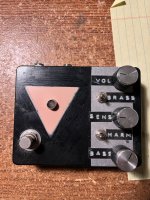mzy12
Active member
Hello! I recently got a Brassmaster PCB from Fuzz Dog (pedalparts.co.uk) and I was wondering if anyone here has any interesting mods they know of for this pedal. I really like Zachary Rizer's demo of the Hiero B.E.A.D. and I'd like to add some the functionality of that unit to my build. One of them is a tone pot for both the main effect (external control) and the clean blend (internal pot). That's an easy add with just something like a SWTC from AMZ.
Thanks in advance for any pointers!
(P.S. Zachary has some incredible videos on his channel of him demonstrating some great sounding effects with his great bass playing, if anyone's interested)
Thanks in advance for any pointers!
(P.S. Zachary has some incredible videos on his channel of him demonstrating some great sounding effects with his great bass playing, if anyone's interested)



